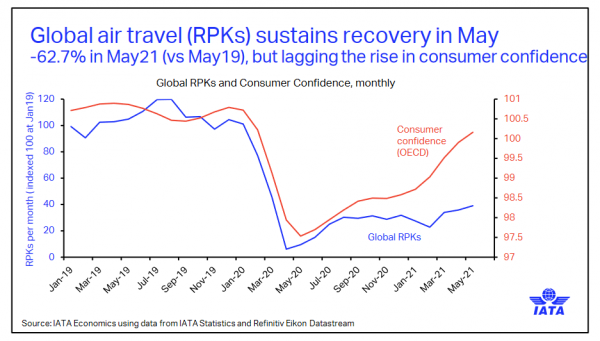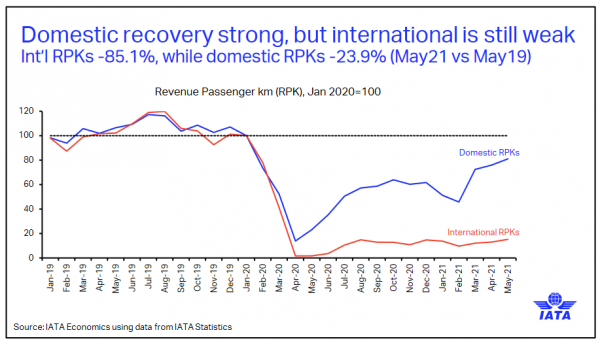GENEVA, 9 July 2021: International and domestic travel demand showed marginal improvements in May 2021, compared to the previous month, but traffic remained well below pre-pandemic levels according to the International Air Transport Association (IATA) latest update.
IATA warns that recovery in international traffic, in particular, continues to be stymied by extensive government travel restrictions.
Because comparisons between 2021 and 2020 monthly results are distorted by the extraordinary impact of Covid-19, unless otherwise noted, all comparisons are to May 2019.


Total demand for air travel in May 2021 (measured in revenue passenger kilometres or RPKs) was down 62.7% compared to May 2019. That was an improvement over the 65.2% decline recorded in April 2021 versus April 2019.
International passenger demand in May was 85.1% below May 2019, a small step-up from the 87.2% decline recorded in April 2021 versus two years ago. All regions, except for Asia-Pacific, contributed to this modest improvement.
Total domestic demand was down 23.9% versus pre-crisis levels (May 2019), slightly improved over April 2021, when domestic traffic was down 25.5% versus the 2019 period. China and Russia traffic continue to be in positive growth territory compared to pre-COVID-19 levels, while India and Japan saw significant deterioration amid new variants and outbreaks.
“We are starting to see positive developments, with some international markets opening to vaccinated travellers. The Northern Hemisphere summer travel season is now fully arrived. And it is disappointing that more governments are not moving more rapidly to use data to drive border opening strategies that would help revive tourism jobs and reunite families,” said IATA’s director-general Willie Walsh.
International Passenger Markets
|
May 2021(% chg vs the same month in 2019) |
World share1 |
RPK |
ASK |
PLF (%-pt)2 |
PLF (level)3 |
|
Total Market |
100.0% |
-62.7% |
-53.7% |
-15.9% |
65.8% |
|
Africa |
1.9% |
-69.4% |
-60.9% |
-14.8% |
53.0% |
|
Asia Pacific |
38.6% |
-59.5% |
-52.0% |
-12.6% |
67.8% |
|
Europe |
23.7% |
-77.9% |
-68.8% |
-24.4% |
59.3% |
|
Latin America |
5.7% |
-57.4% |
-53.8% |
-6.5% |
76.8% |
|
Middle East |
7.4% |
-79.6% |
-61.6% |
-34.1% |
38.9% |
|
North America |
22.7% |
-44.0% |
-33.8% |
-13.3% |
72.8% |
1% of industry RPKs in 2020 2Change in load factor vs 2019 3Load Factor Level
- European carriers‘ May international traffic declined 84.7% versus May 2019, improved from the 87.7% decrease in April compared to the same month in 2019. Capacity dropped 75.7%, and load factor fell 31.3 percentage points to 52.9%.
- Asia-Pacific airlines saw their May international traffic fall 94.3% compared to May 2019, fractionally worse than the 94.2% drop registered in April 2021 versus April 2019. The region experienced the steepest traffic declines for a tenth consecutive month. Capacity was down 86.4%, and the load factor sank 45.5 percentage points to 33.2%, the lowest among regions.
- Middle Eastern airlines experienced an 81.3% demand drop in May compared to May 2019, slightly bettering the 82.9% decrease in April versus the same month in 2019. Capacity declined 63.7%, and load factor fell 35.3 percentage points to 37.7%.
- North American carriers‘ May demand fell 74.4% compared to the 2019 period, an improvement over the 77.6% decline in April versus two years ago. Capacity sagged 58.5%, and load factor dropped 32.2 percentage points to 51.7%.
- Latin American airlines saw a 75.1% demand drop in May, compared to the same month in 2019, notably improved over the 80.9% decline in April compared to April 2019. May capacity was down 69.9%, and the load factor decreased 14.6 percentage points to 69.5%, which was the highest load factor among the regions for the eighth consecutive month.
- African airlines’ traffic fell 71.4% in May versus May two years ago, an increase from the 75.6% decline in April compared to April 2019. May capacity declined 61.8% versus May 2019, and load factor dropped 16.9 percentage points to 50.2%.
(Source: IATA)







